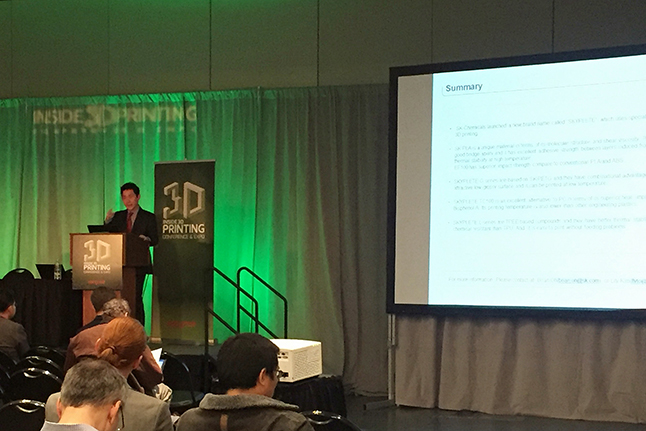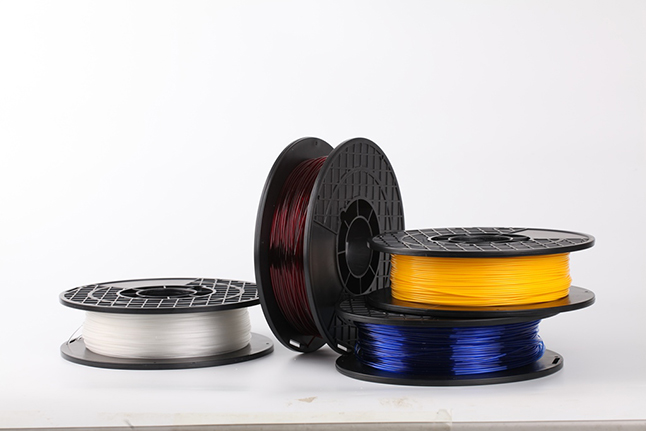● SK chemicals Debuts SKYPLETE at Inside 3D Printing Conference & Expo
- Announces Innovative Material as the Sole South Korean Company at Professional 3D Printing Materials Conference
- Problems Associated with PC, PLA, and ABS Solved... Set to Lead the 3D Printer Filament Material Market
- New Filament Material Announced at Inside 3D Printing New York
SK chemicals has recently launched their new 3D printer filament material at the Inside 3D Printing Conference & Expo held in New York.
SK chemicals (Cheol Kim, President) announced on the 21st of this month that the company debuted SKYPLETE, an innovative material for 3D printing, at this year`s Inside 3D Printing Conference & Expo held in New York, being the only South Korean company at the event.
As a brand of plastic filament material for 3D printing, SKYPLETE consists of four product families including the G- and E-Series. The new material was well received by industry professionals for solving problems associated with PLA, ABS, and PC, the current primary filament materials.
With PC and ABS, there is a concern of generating harmful environmental hormones such as volatile organic compounds (VOC) and bisphenol A (BPA) when 3D printing at over 230 °C. In addition, the materials have been widely recognized as unsuitable for industrial use as they are prone to warping.
The G-Series, introduced at this year`s conference, is an environment-friendly material that has acquired U.S. FDA certification and been proven to be safe enough to be used for pharmaceutical packaging. In addition, unlike ABS, little odor is produced during the manufacturing process. Notably, the material has been recognized as being suitable for making sophisticated industrial products, as stable production without warping is possible as well as a variety of finishes including high-gloss and matte.
The E-Series has also garnered great interest from people in the industry due to its PLA-like biodegradable quality and increased heat resistance. While PLA is capable of withstanding temperatures as high as 50 °C, the E-Series can withstand temperatures up to 100 °C. What`s more, productivity can be increased as the E-Series is capable of printing more than two times faster than conventional PLA.
Jun-seok Oh, the Business Development Manager of SK chemicals and presenter at this year`s conference, stated, “The use of 3D printing has expanded from personal hobby to industrial use.” He added, “SKYPLETE, which compensates for the shortcomings of existing filament materials such as PC, ABS, and PLA, will continue to lead the 3D printer filament material market into the future.”
According to the 2016 Wohlers Report on 3D printing, the market size for 3D printer filament materials is at ₩900 billion annually as of 2015, and a high annual growth rate of 20% is expected moving forward. Kicking off with this year`s Inside 3D Printing Conference, SK chemicals intends to pursue a share of more than 40% of the world`s 3D printer filament materials market with a strong focus in North America.

[Photo]
Jun-seok Oh (Business Development Manager) of SK chemicals introducing SKYPLETE at Inside 3D Printing Conference & Expo.

[Photo]
3D printer filament made from SKYPLETE.
[Glossary]
* Inside 3D Printing
Currently one of the top five professional 3D printing events world-wide, the Inside 3D Printing Conference & Expo began in New York in 2013 and has been held in 22 major cities around the world. Industry professionals working with 3D printing technologies gather to share the latest in 3D printing technologies, trends, and applications.
* Volatile Organic Compounds (VOC)
Refers to liquid or solid organic compounds that are continuously volatilized and released into the air at a constant temperature and pressure.
* Warping
A distortion or shrinkage that occurs as the printout material from a high-temperature 3D printer cools in ambient temperature. Often revealed as curled edges.
* PLA
Eco-friendly resin made of raw materials extracted from corn starch. Prints more precise than ABS are possible due to less shrinkage from thermal deformation. However, prints can melt in ambient temperatures above 60 °C due to low durability, and the surface finish is not as smooth as ABS.
* Compounding
A process for producing new plastics according to a specific purpose by mixing raw materials of polymer plastics in an appropriate ratio.